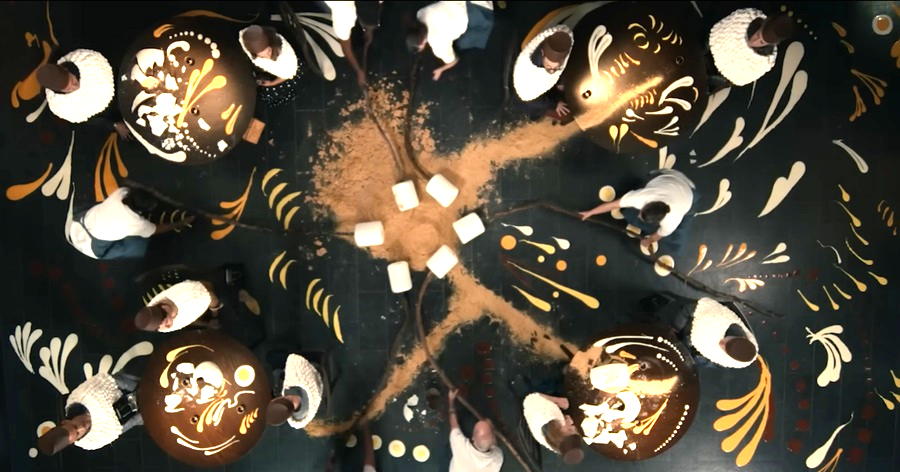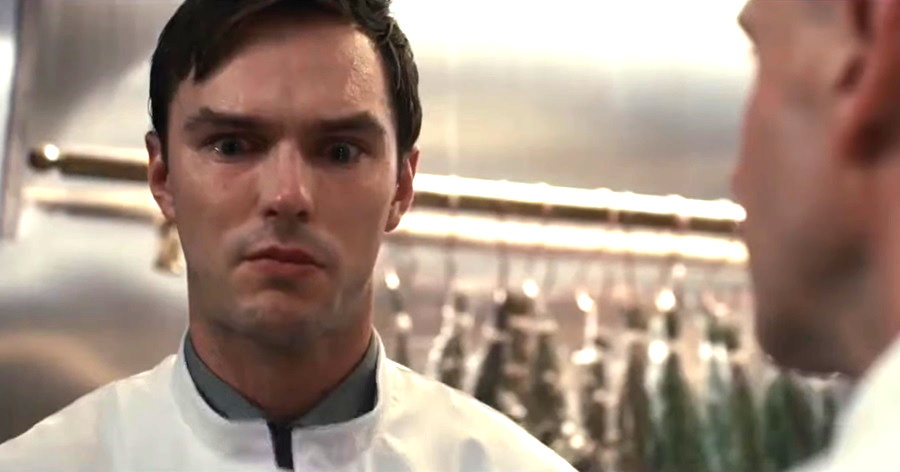The Menu is a darkly satirical thriller directed by Mark Mylod, blending elements of horror with biting social commentary. The film centres on an exclusive dining experience at Hawthorne, a remote and high-end restaurant run by the enigmatic and perfectionist Chef Slowik (Ralph Fiennes). The story follows a group of affluent and influential guests who have been invited to a one-of-a-kind tasting menu prepared by the esteemed chef.
The cast includes Anya Taylor-Joy as Margot, a last-minute replacement for another guest, and Nicholas Hoult as Tyler, her food-obsessed partner. The other guests are a mix of wealthy and powerful figures, including a food critic (Janet McTeer), a movie star (John Leguizamo), and a tech billionaire (Theo James). As the evening progresses, it becomes clear that the meticulously crafted dishes are not just culinary delights but a part of a much darker and more elaborate plan orchestrated by Chef Slowik.
The Unfolding Drama: What Happens at Hawthorne
As the evening unfolds, the guests are treated to an array of increasingly bizarre and unsettling courses. Each dish is accompanied by a performance that reveals Chef Slowik’s deep-seated grievances and dissatisfaction with his life and career. The seemingly perfect dining experience quickly turns sinister as the chef exposes the flaws and superficialities of his high-profile patrons.
The film’s atmosphere grows increasingly tense as it becomes evident that the dinner is more than just a meal—it is a meticulously planned and orchestrated event with a grim purpose. The guests’ reactions range from confusion to horror as they realize they are part of a nightmarish spectacle.
Explaining the Ending of The Menu: The Bitter Finale
The ending of The Menu is a shocking culmination of Chef Slowik’s elaborate plan. As the final course approaches, Chef Slowik reveals his ultimate intention: to exact revenge on the elite and privileged individuals who have come to his restaurant. It becomes clear that the entire evening has been a carefully designed act of retribution.
The final course, which is the most elaborate and theatrical of all, is the chef’s pièce de résistance. It includes a dramatic and grotesque presentation, where the chef forces the guests to confront their own moral and ethical failings. The climax of the film reveals that the dinner was not just a culinary event but a staged execution. The chef’s personal vendetta against the guests is tied to his own disillusionment with the culinary world and the superficiality of his patrons.
Margot (Anya Taylor-Joy), who is revealed to be a late addition to the guest list, becomes a pivotal character in the climax. Unlike the other guests, Margot is not part of the elite circles and her presence challenges the chef’s plan. Her confrontation with Chef Slowik highlights the film’s underlying themes of class conflict and the consequences of an unchecked obsession with perfection.
In a chilling final twist, Margot’s attempt to escape or negotiate her way out of the situation reveals the chef’s ultimate plan. The ending is a powerful commentary on the nature of privilege, art, and the consequences of arrogance. Chef Slowik’s final act is both a statement and a punishment for the excesses and moral bankruptcy of his guests.
How the Director Mark Mylod Explained the Ending Of The Menu
Director Mark Mylod has offered insights into the ending of The Menu, emphasizing the film’s thematic depth and satirical nature. According to Mylod, the film is a commentary on the disconnect between the creators and their consumers, particularly in the world of high cuisine.
Mylod explained that Chef Slowik’s elaborate plan was designed not only to address his personal grievances but also to critique the way art and artistry are often consumed superficially by those in power. He highlighted that the chef’s drastic actions reflect a broader frustration with the lack of genuine appreciation for the creative process and the way art can be reduced to mere spectacle.
The director noted that Margot’s role as an outsider was crucial in revealing the core message of the film. Her presence at the dinner disrupts the chef’s plans and forces a confrontation with the chef’s own ideals and motivations. Mylod’s commentary underscores that the film’s ending is not just about the chef’s revenge but also about the larger social commentary on elitism and the commodification of art.
The Final Course: The S’mores Dish

The final course of the evening is particularly striking: it is a deconstructed take on s’mores, presented as a theatrical and grotesque finale. The dish is designed to symbolize the culmination of the chef’s plan and the ultimate downfall of the guests. It involves a dramatic and visually arresting presentation that ties into the film’s broader themes of consumption, excess, and moral reckoning. The s’mores dish, with its elaborate and disturbing execution, serves as both a literal and metaphorical final course, emphasizing the chef’s message about the nature of indulgence and the consequences of privilege.
Why the Guests Did Not Try to Escape
Throughout the evening, the guests remain largely passive and compliant, despite the increasingly unsettling nature of the events unfolding around them. Several factors contribute to their inaction. Firstly, the guests are initially in denial about the true nature of the evening, unable to fully grasp the gravity of the situation until it is too late. Secondly, their sense of entitlement and privilege leads them to believe that they are somehow above the consequences of the chef’s plan. Finally, the atmosphere of fear and manipulation orchestrated by Chef Slowik and his staff creates an environment where the guests feel powerless and resigned to their fate.
Why did the Staff Blindly Followed Chef Slowik’s Plan?
The staff at Hawthorne is deeply loyal to Chef Slowik and is complicit in his plan for several reasons. They are portrayed as being fully invested in the chef’s vision and philosophy, having been part of his journey and his vision of culinary perfection. Their involvement is a testament to the intense culture of devotion and hierarchy within the restaurant world, where subordinates often align with their leader’s ambitions and ideals.
Moreover, Chef Slowik’s plan is framed as a culmination of years of frustration and disenchantment with the superficiality of the dining industry and the guests who embody its excesses. The staff’s participation reflects their shared disillusionment and desire to be part of a grand, albeit horrific, statement against the very people who have taken their artistry for granted.
The Order Given by Margot and Tyler’s Demise
In a pivotal moment, Margot (Anya Taylor-Joy) orders a cheeseburger, a stark contrast to the sophisticated dishes presented throughout the evening. This seemingly simple request symbolizes her rejection of the pretentiousness and excesses of the haute cuisine experience. Her order, combined with her genuine appreciation for food, serves as a critical turning point in the narrative.

Tyler (Nicholas Hoult), who is obsessed with the culinary art and has been complicit in the evening’s events, is deeply affected by Margot’s request. In a moment of desperation and disillusionment, he confronts Chef Slowik (Ralph Fiennes) and, after a whispered conversation, takes his own life. The chef’s whispered words to Tyler are not explicitly detailed in the film but are implied to be a mix of taunting and a final acknowledgment of Tyler’s misguided devotion. This act of suicide underscores Tyler’s ultimate realization of the futility and absurdity of his obsession with high cuisine.
Why Margot Was Allowed to Leave: Theories and Speculations
In the climactic moments of The Menu, Margot (Anya Taylor-Joy) is granted the unusual opportunity to leave the restaurant, a stark contrast to the fate of the other guests. This decision by Chef Slowik (Ralph Fiennes) is both pivotal and enigmatic, leading to various theories and fan speculations about her ultimate fate.
Why Margot Was Allowed to Leave
Margot's departure from Hawthorne is symbolically and narratively significant. Unlike the other guests, Margot is not part of the elite social circles that Chef Slowik resents. Her genuine appreciation for food and her stark contrast to the superficiality of the other diners play a crucial role in her fate. Margot’s request for a simple cheeseburger, a far cry from the haute cuisine being served, represents a return to authenticity and simplicity—qualities that Chef Slowik seems to value in contrast to the pretentiousness of his other patrons.
Chef Slowik’s decision to allow Margot to leave can be interpreted as an acknowledgment of her intrinsic honesty and her rejection of the elitism embodied by the other guests. It reflects a deeper critique of the societal values that the chef is condemning. Her escape from the night’s grim conclusion symbolizes a potential for redemption or at least an exemption from the consequences that befall those who represent the excesses and moral failings Chef Slowik despises.
Theories and Speculations About Margot's Fate
Fans have speculated about Margot’s fate following her departure from Hawthorne, given the film’s ambiguous ending and the intense nature of the evening's events. Here are some prominent theories:
1. A New Beginning: Some viewers believe that Margot’s escape represents a fresh start for her, freed from the moral corruption embodied by the other guests. Her departure is seen as a chance to pursue a more authentic and meaningful life, away from the trappings of high society.
2. A Deeper Connection with Chef Slowik: Another theory posits that Margot's exit is part of a more complex plan orchestrated by Chef Slowik. In this view, her escape might be a form of manipulation, with the chef testing or challenging her values and actions as part of his larger statement on the culinary and social elite.
3. A Grim Reality: Some fans speculate that Margot's departure might not be as liberating as it appears. Given the dark and twisted nature of the evening, there is a suggestion that her escape could be a temporary reprieve or that she might face unforeseen consequences later on. This theory reflects a more pessimistic view of the film’s exploration of moral and social themes.
4. The Chef’s Final Act of Defiance: Another perspective suggests that Chef Slowik's decision to let Margot go is an ironic final act of defiance, emphasizing the chef’s disdain for the guests’ superficiality and the absurdity of the high society they represent. Margot's exit becomes a part of the chef's broader critique rather than an indication of her personal redemption.
These theories highlight the film’s open-ended nature and the complex layers of meaning behind Margot’s ultimate fate. The Menu leaves viewers pondering the implications of its characters' actions and the broader commentary on social and artistic values.
Conclusion: A Disturbing Reflection on High Society
The Menu is a thought-provoking and unsettling film that challenges viewers to reconsider their perceptions of art, privilege, and the consequences of unchecked ambition. The ending’s dark and dramatic twist provides a powerful commentary on the superficiality and moral decay of elite society, leaving audiences to reflect on the price of perfection and the true value of artistic integrity.
As the credits roll, The Menu lingers in the mind, forcing us to confront uncomfortable truths about ourselves and the world we inhabit. It’s a culinary experience that serves up a bitter lesson on the cost of indulgence and the perils of excess.






